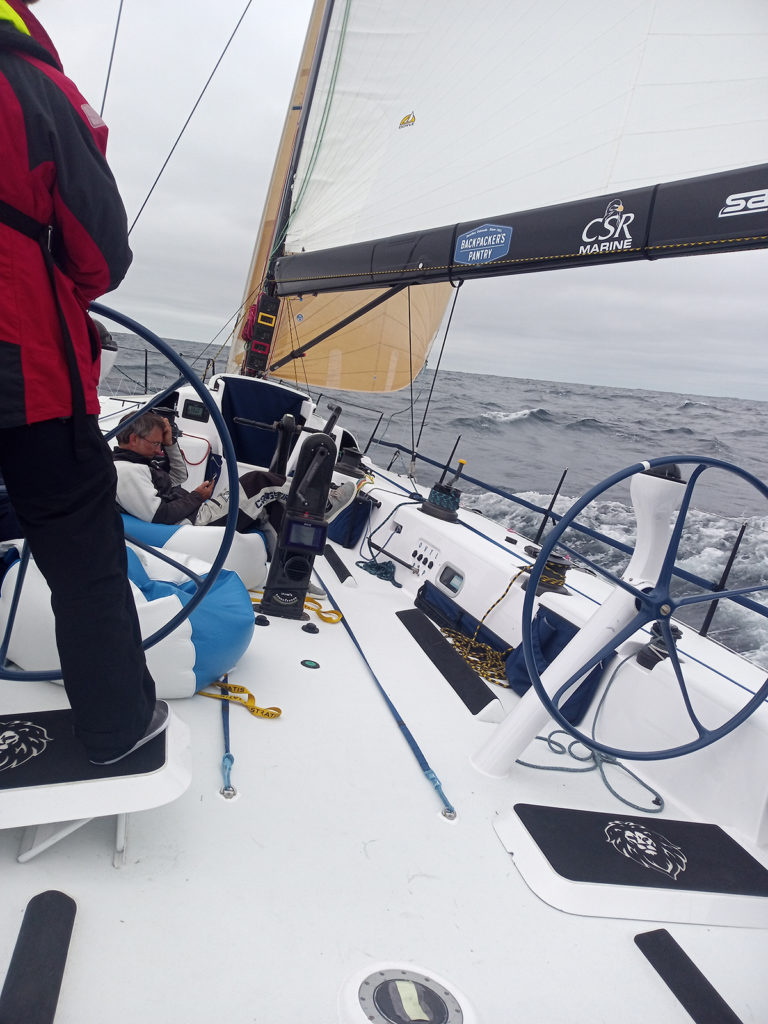
CALIFORNIA, HERE WE COME
NIGEL BARRON recounts the “practice run” that was the delivery of Zvi to Los Angeles in anticipation of the July 17th start of Transpac 2021.
Step one of the Transpac triangle: The trip from Seattle to Los Angeles. On paper, it’s pretty simple—leave Seattle, make three left turns and you’re in Los Angeles.
Of course, we all know things are never that simple. As we got closer to our planned June 18th departure, it became clear that we would take a beating in the Strait of Juan de Fuca from Port Angeles to Seiku. The decision was made to push the departure to 4 a.m. on Saturday, June 19th. We left the slip around 4:15 a.m. and started motoring north. By sundown on Saturday, we exited the strait into a fog bank. We did not see the sun for the next five days.
As with any trip offshore, the first few days are the hardest as people adjust to life at sea. We’d planned for this with each day’s food in a numbered bag. Early in the trip, the food bags consist of lighter meals, snacks, fruit chews—things that are easy on an unsettled stomach.
The weather didn’t help. As we got into the first night, we were seeing pretty steady winds of 15-25 knots from the northwest. The angles were nice for a downwind trip, but the total darkness was tough on the new guys who hadn’t been offshore. Driving by instruments only, without moon or stars and total cloud cover, taxes the mind. You need confidence in the instruments, as well as what your body feels.
Our weather routing was provided by Roger “Clouds” Badham, who has participated in every America’s Cup since 1983. The plan didn’t change too much as we got closer to the departure and even during the trip. Go offshore for better wind, come inshore for less wind and a motor. We opted for the offshore route. By the time we were in northern California, we were around 100 miles off the coast and ended up a maximum of 160 miles off the coast.
By the third day, everyone was starting to feel a lot better with enough watches under their belts to get caught up on sleep. Eight people sailed this leg. We ran two watches of four people on a 4-4-4-6-6 watch schedule, in terms of hours on and off. Basically, we ran three watches at night and then two longer watches in the daylight.
The normalizing of conditions also allowed me to ramp up communications with our shore team. This was the last big shakedown of the boat and systems. We had a new custom alternator from Mark Grasser at DC Power Solutions that we needed to test under real life conditions. This alternator puts out 185 amps attached to our little 75hp Yanmar. We started making water with our Spectra watermaker to check amp draws and production. It worked well, but we discovered at over 16 knots of boat speed the watermaker struggles a little bit with aeration.
Without question, the highlight of the trip has to be the last day where we came through the Santa Barbara Channel with 26 knots of boat speed in steady 32- to 37-knot winds. We flew, but under control. By the time we were near Malibu, we had taken the main down so we could get that done while there was still some light and settled in to motor the rest of the way to Los Angeles.
The trip validated the many hours so many people have contributed to make racing to Hawaii possible. I head back down July 9th to load our shipping container, and our start for Transpac is July 17th. >> Nigel will give us his account of the race to Hawaii in next month’s column, but for those who just can’t wait, real-time Transpac race results can be found transpacyc.com.


